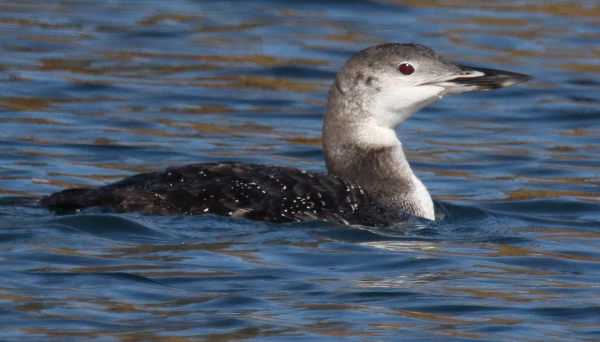
It was exciting to find a flock of molting Common Loons to photograph on a remote northern Minnesota lake, surrounded by fall colors.

Each of the 6 loons showed a different mix of alternate and basic plumage, with this individual showing an advanced molt.
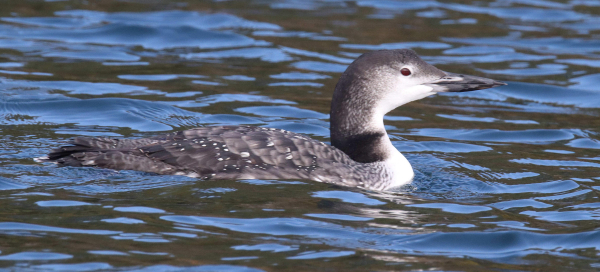
You can see more photographs of the molting Common Loons in this issue’s Bird Photography feature.
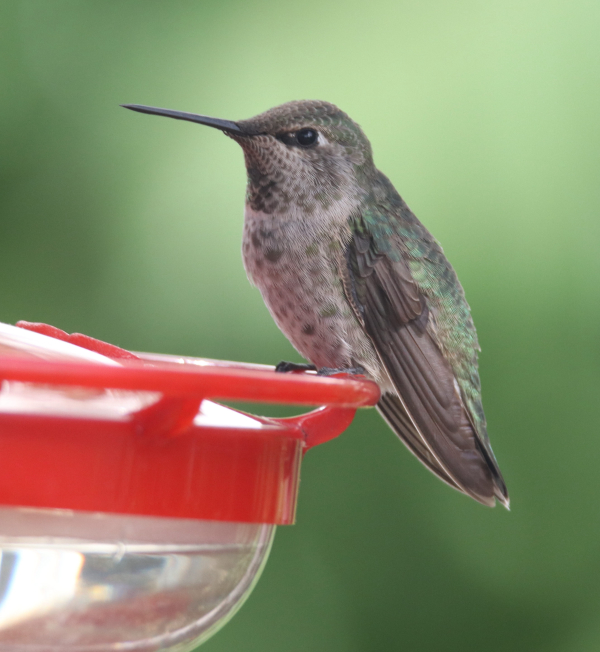
A chance to photograph the young male Ruby-throated Hummingbird at close quarters during his extended October visit is the focus of the following article.
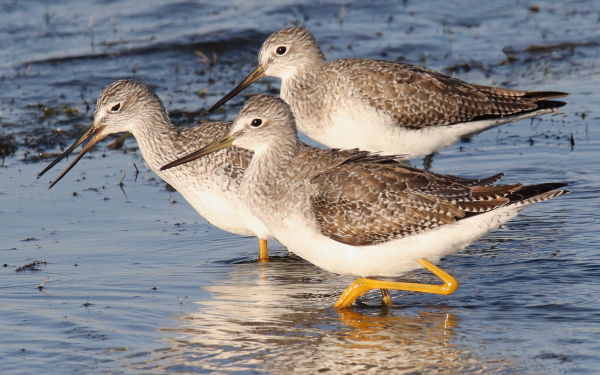
A few shorebirds continue to appear on the shore of Charo Marsh, including the Greater Yellowlegs above, and the Long-billed Dowitcher below.
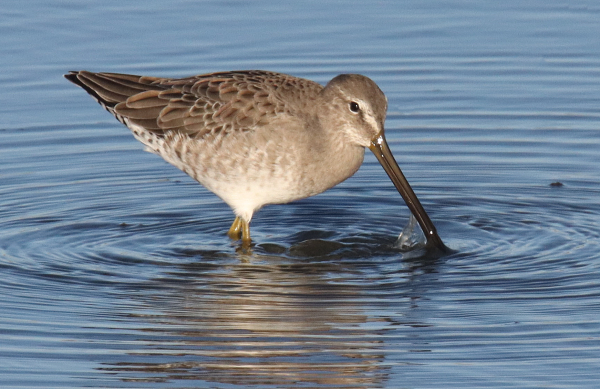
|
The crisp October morning drew me to the second floor deck that had a full view of the east and west shores of the elongated northern Minnesota lake where I could watch bird migration in motion. Flocks of Yellow-rumped Warblers, American Robins, and Blue Jays; Ring-billed Gulls and American Crows, all following the east shore and passing overhead flock after flock. One large flock of warblers worked its way through the mix of birch trees and aspens filled with yellow leaves, providing me with closer binocular views that revealed an Orange-crowned Warbler among the Yellow-rumps as Black-capped Chickadees called nearby.
Before me, it seemed unusual that this beautiful woodland-lined lake’s calm, deep water showed not a bird on its surface. Where were the loons, ducks, and geese? Perhaps it was late for loons, maybe early for many ducks and geese, but I retained hope. The morning quiet revealed the rustling sounds of the colorful leaves, even revealing the sound of each leaf as it touched the ground – it was a time to become deeply immersed with nature. But a single loud sharp cry broke the silence – a loon? I checked the lake but nothing showed on the water; aah, a young Bald Eagle was suddenly sailing above the trees. Did it call, or did a loon call at the sight of the eagle?
As I watched the eagle glide and circle above the shoreline where the trees met the water, a Common Loon suddenly surfaced fairly close in the water below me. It was a loon call after all, and as I watched it through binoculars it dived in my direction. Hoping for a chance to photograph it, I headed for the ground floor and the shoreline beyond, when I met my friend Pat at the doorway. I was visiting Pat at his Northwoods home, and after explaining I was headed for a loon photo op he grabbed a sweatshirt to join me. After an initial watch for the loon, we sat in comfortable chairs on his dock to visit while watching for birds – until I spied 2 loons swimming quite a distance to the north, and then another one. Pat quickly suggested we hop in a boat get some water-based photos, and so another loon photo adventure began.
The water was a beautiful blue color with the faintest breeze adding light ripples to it and we quietly cruised in search of the loons. In short order, we sighted 2, then 3, then 4 loons! No, there were 6! The loons permitted our slow, quiet approach and we spent the next hour shadowing their fishing activities as they split into groups of 3, 2, and 1 at times, and reunited as a group of 5 another time to preen in a tight flock. It was a marvelous time, and Pat became so enthused about the photo experience that he lost track of time, which is always a good thing, and usually hard to do for the CEO of an international aeronautics company. (For me, I can lose track of time while photographing till the sun goes down, especially with a flock of loons before me.) Pat turned out to be a great bird photography boat pilot too during his first introduction this birding activity.
The loons were in the midst of their fall molting period, which began in late August and would probably continue through October, judging from their mix of basic and alternate plumage, which was nearest the basic (winter) plumage. And that's why it was such an opportunity to have 6 Common Loons before us showing a variety of stages of molting. I could document the differences between the loons during a period when most people never see loons – immediately before or during migration, which is happening now in the Minnesota Northwoods. I share the whole story in this week’s Bird Photography feature with photos of the birds, which could be identified individually by their molt patterns.
Itasca and Tamarack
The headwaters of the Mississippi River are not far from Pat’s northwoods paradise, adding to the allure of this remote area of colorful forest. As I drove through the beautiful fall landscape, I appreciated that each colorful leaf is like a flower on a tree, one that changes from green to pale green and yellow, or green to orange, then red, depending on the species of trees. Soon after entering Itaska State Park and adjoining wilderness area a pair of Trumpeter Swans caught my attention. Beautiful white birds swimming among clusters of water lily pads with red and green leaves reflecting on the surface of the shallow water. But wait, there was another pair of Trumpeters at the other end of the pond.
As I was photographing the first pair, I sighted an adult Bald Eagle in flight behind them. It was circling, hopefully in my direction, but while I took a couple initial photos, another adult Bald Eagle glided in above the first one. They circled one another a bit farther away, when I realized 2 more adult Bald Eagles were dropping in on a high glide – how patriotic of them. None of the eagles came closer, but it was fun having the swans to photograph. Beyond these mega-species, I observed a White-breasted Nuthatch, some Dark-eyed Juncos and a few Northern Flickers, with plenty of evidence of other woodpeckers, including the big Pileated Woodpeckers – wouldn’t it be nice to find one!
Next I headed for Tamarack National Wildlife Refuge, where I stopped short when I found a pair of Trumpeter Swans with 2 fledged cygnets and another pair of Trumpeters 60 feet away. In fact, there was a third pair with a single cygnet across the road. In a moment a young Northern Harrier flew low over the marsh on the hunt, as did a second one a minute later. They began a circling flight for a few moments before both flew in a southerly direction. Next was a mixed flock of White-throated Sparrows and Dark-eyed Juncos feeding, the White-throats being the first of fall I’ve seen.
Then it happened – a Pileated Woodpecker flew in a low direct line that took it through the sun, blinding me from seeing more – ha, but I found one! There was also a Common Raven, a few American Crows, Blue Jays, and Northern Flickers. And before I left the refuge, 2 more pairs of Trumpeter Swans, 1 pair with a fledged cygnet, and occasional Blue-winged Teal and American Coots. Tamarack Refuge was pretty birdy during my relatively brief drive-through, so I’ll hafta return soon.
Local Birding Highlights
As I mentioned last week, it’s also that time of the year when Swainson’s Hawks vacate the high plains to begin their long migration to the South American grasslands centered in northern Argentina. Very few remain in North Dakota by October 1st, and that fact was verified when my last Swainson’s Hawk sighting was Sunday (September 29th), when I checked out a familiar adult Swainson’s Hawk perched south of Charo Marsh. Monday I referred to the HawkWatch totals for October 7 and saw that almost 79,000 Swainson’s Hawks passed over Veracruz, Mexico among a total of 137,070 raptors that day! No fooling around, the Swainson’s Hawks are well on their way to South America!
While birding Saturday I realized that I hadn’t seen a Franklin’s Gull the past few days, and that Black Terns have been absent for about 2 weeks, which underlines how hard it is to notice when species leave an area during migration. With exceptionally high winds from the south Friday and from the west Saturday, birding was poor at best, but I checked on Charo Marsh where a little flock of 7 Greater Yellowlegs were foraging together, providing a rare photo of 3 in very close association. Saturday there were only a few Killdeer on hand at Charo, but a flock of about 40 Long-billed Dowitchers surprised me as they were feeding behind the wind break of tall cattails near the shore of Alice’s Marsh a mile-plus north of my office.
Friday morning at home revealed a flurry of Yellow-rumped Warblers in my yard throughout the day. Conversely, Saturday I only sighted 1 Yellow-rump in my trees. Sunday there were several Yellow-rumps in my yard, along with a few White-throated Sparrows – obviously there had been an overnight flight on the tail of the west wind. But I was not prepared for the new birds I would see during my late afternoon birding drive: Starting just 100 yards away, a flock of about 8 American Robins was feeding, drinking, and bathing. That’s when the Harris’s Sparrows, Dark-eyed Juncos, White-throated Sparrows, and the first of the year White-crowned Sparrows appeared and began foraging for weed seeds a few feet away, with a few Harris’s and juncos having a drink too. There were a some other small flocks of native sparrows and juncos in the area, numbering up to 10, which was a great start tothe birding action.
A foursome of American Avocets and a Greater Yellowlegs were standouts at Melody’s Marsh, and at Charo Marsh I photographed 7 Long-billed Dowitchers in a small flock that grew to 12, and then to 25. But in the midst of my photography, I’m sure my mouth dropped open as 3 Tundra Swans flew over the water as though checking it out, circling, then landing in a distant bay – the first Tundra Swans of the season! They were kinda early I thought, and at first I couldn’t ascertain they were Tundras or Trumpeters, but it was a joy to witness their arrival. The last jolt of excitement was the view of a large falcon about 4 miles from my office. I expected the falcon was probably a young Peregrine, but a closer look with better lighting showed it to be a Prairie Falcon; a beauty, and the first of this fall.
Monday was the most beautiful day for birding you could wish for, which made me slip out of my office earlier than usual, with the promise of working late into the night to catch up on my work. I decided to do an extended birding drive that I sometimes refer to as my raptor route, but it also passes by the best swan lakes in the region. What were the chances of finding other Tundra Swans now? Along the way I counted 21 raptors including 11 Red-tailed Hawks, 9 Northern Harriers, and 1 adult Bald Eagle that was standing on a tiny island in the middle of a large lake near a widely spread group of 76 Tundra Swans! Yes, there were other swans in the area, but only at this location, and at Charo the day before.
Most of the swans were in adult or subadult plumage (they look alike), but 1 pair had 3 grown cygnets with them, and another had 1 cygnet. More family groups will fly in from their Arctic nesting range as October progresses, and I look forward to that. Along the drive there were also scattered Western Meadowlarks and Northern Flickers, a few Savannah Sparrows, Clay-colored Sparrows, and Song Sparrows, a male Ring-necked Pheasant, a Sharp-tailed Grouse, a White-faced Ibis, a Snowy Egret, and flocks of White Pelicans and Double-crested Cormorants. Ducks were common, with many more Northern Pintails on hand, along with Canvasbacks, Redheads, Mallards, and Green-winged Teal – plus many flocks of American Coots; it was a revealing fieldtrip.
As described in the following article, I’m glad to report that the young male Ruby-throated Hummingbird that arrived at my feeding station late in the season (for this latitude), on September 29, continues to add a few little thrills each day as I work. It’s nice how a single bird, or a variety of birds, can add so much to our days at work or at home. That’s equally true as birds we see in the field activate our interest in getting a look at what birds are present wherever we go – especially as we are reaching another peak in the fall migration season. I hope you enjoy the week ahead, and hope you can join the birding celebration Saturday as part of this year’s October Big Day!
Article and Photos by Paul Konrad
Share your bird sightings and photographs at editorstbw2@gmail.com